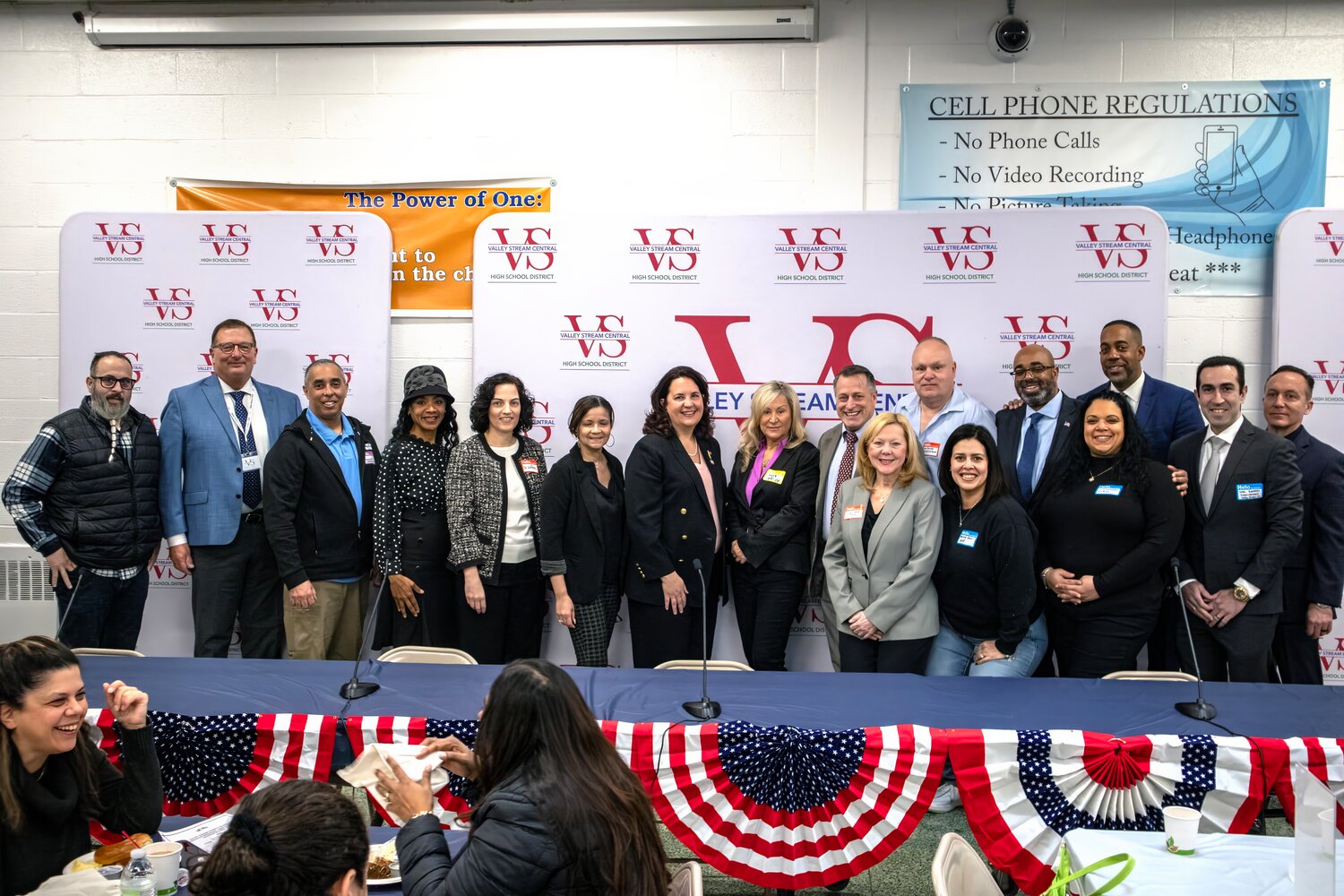The future of school funding in focus at Valley Stream leadership breakfast
Valley Stream families and students heard from local lawmakers and school administrators and got their questions answered on pressing education issues at the annual Valley Stream Legislative Breakfast.
The public forum March 9, hosted by the Valley Stream Council of PTAs, has promoted itself as a rare occasion for residents to sit down with local leaders in a genuine dialogue on the best ways to deliver better educational outcomes for students going into the new year.
This year, Assemblyman Brian Curran and State Senator Patricia Canzoneri-Fitzpatrick, Republicans, sat shoulder-to-shoulder with Democratic Assemblywoman Michaelle Solages as legislative panelists.
The conversation ran the gamut of education topics from top statewide issues like the expansion of universal pre-K and the quandary over the governor’s new state aid funding formula — down to more local concerns including shoring up more culturally sensitive language teachers to new ways of transitioning special education students into adult life.
Unal Karakas, District 24 Superintendent, was tapped to speak on behalf of his fellow superintendents and board of education members. In his speech, he outlined an extensive list of education policy reforms he urged the trio of lawmakers to take to Albany including:
- Ensuring a legal pathway to make school funding permanent for the federal free meals program
- Make state evaluations of teachers and principals less test-score-driven
- Fuller access to funds for universal pre-K funding by eliminating certain funding restrictions based on class-size requirements
But perhaps the issue overshadowing all others was the question of state aid funding.
School leaders, lawmakers say 'no' to state formula changes
Karakas, who, like many school district leaders on Long Island, made no effort to hide his opposition toward Governor Kathy Hochul’s proposal to change elements to the state aid funding formula —which decides how much state dollars get pumped to support schools—described it in plain terms as a financial blow to public education.
“We must continue to advocate for the reinstatement of the ‘save harmless’ provision. Investing in public education is an investment into the future of our society,” he said. “And we must never curtail that funding.”
The exact policy change that has convulsed many school districts mainly boils down to one thing: the “save harmless” or the “hold harmless” provision. For decades, the provision guaranteed school districts get at least as much foundation aid this year as they did the last. Education stakeholders say the provision has provided a predictable baseline of funding for districts when planning their budgets.
Hochul says school funding method is unfair, obsolete
Hochul, however, wants to scrap the provision, arguing that doing so will give the state more flexibility in allocating state funds to the schools that need it most.
She asserts that the overwhelming majority of school districts impacted by the change are over-resourced—having far fewer students than in previous years yet sitting on a cash surplus in their reserve funds.
Following years of historic increases in education funding, the current funding formula is no longer “sustainable,” argues Hochul, and its distribution of funds has proven deeply unfair, enabling more money to be funneled to districts with higher property values than less-wealthier areas.
But without the cash safety net provided by the “save harmless” provision, critics point out it’s not just moderate to high wealthy school districts that bear the brunt. Several low-income, rural school districts, which have fallen short in financing their schools on revenue generated from property taxes, could also see millions of funding dollars fizzle under the new formula.
Karakas also noted that the “save harmless” provision is just one factor in a complicated formula of weighted factors that determine how state funding is divided each year among school districts. Hochul seeks to rewrite other elements of the formula as well, namely how the consumer price index is calculated.
As it stands, the CPI is adjusted annually based on the CPI from the previous year, but Hochul plans on using a ten-year average and dropping the highest and lowest years.
Karakas said this “altered” version promises to “lead to substantial cuts in foundation aid to schools despite nominal increases.”
While her critics may concede the funding formula needs fixing, the financial shakeup produced by the governor’s bold efforts to forgo long-established features of the formula will be felt far and wide. About 337 school districts across the state, according to an analysis by NYSUT, will see some sort of reduction in their budget. Some will feel that loss more deeply than others.
That same analysis found that next to more well-to-do school districts like Long Beach—where millions of dollars are at stake—the loss is far less critical to Valley Stream public schools.
A 1.3 percent decrease in school aid, for example, is expected for Valley Stream District 13 and District 24. That’s about a $229,000 and a $126,000 cut for each school district, respectively. For comparison, the Long Beach school district could lose up to $4.3 million in state aid.
Lawmakers call for a middle way
Nevertheless, the three lawmakers were practically all of one mind that the governor should pump the breaks on what they described as her “piecemeal” approach to foundation aid formula reform.
Instead, they called for extra time to take input from all relevant stakeholders on a holistic improvement to the state’s antiquated funding formula that can benefit all school districts.
That too, it seems, is the more palatable alternative taken by the state Board of Regents which has called for a $1 million study to explore potential changes in that formula before any action is taken. The board also noted factors like poverty levels, regional costs, property values, and inflation should be weighted more carefully in a revised formula.
Have an opinion on this article? Send an email to jlasso@liherald.com.






